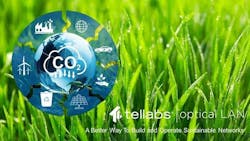New passive optical LAN carbon reduction calculator introduced for smart buildings
Tellabs has made a groundbreaking declaration in the Information and Communications Technologies (ICT) sector, unveiling the inaugural carbon reduction calculator. This tool evaluates both the embodied and operational carbon savings resulting from the adoption of its Optical Local Area Network (LAN) for Smart Buildings and Internet of Things (IoT) connectivity. A Passive Optical LAN is a Layer-2 transport medium, built with Passive Optical Network (PON) technology, which provides converged video, data, wireless, and voice services over a single strand of fiber to the connected device, according to Tellabs.
One of the benefits of Passive Optical LANs is that they have been documented to consume less space and materials in a building’s main data center room, vertical risers, horizontal pathways, and telecommunications rooms. Further, Optical LANs are known to have reduced energy consumption, more efficient Power over Ethernet (PoE) delivery to subtended powered IoT devices, and a lower impact on building air conditioning.
The company’s new carbon calculator can help IT and network professionals as well as architects and engineers determine embodied and operational carbon savings by modeling fiber-based Optical LAN and the equivalent traditional copper-based switched network design to assess each network’s environmental footprint using publicly available carbon data from the EPA’s eGRID factors and critically reviewed Environmental Product Declarations (EPD).
“Now more than ever, businesses should take advantage of Optical LAN’s tangible gains towards sustainability initiatives by embracing its embodied and operational carbon savings,” said Rich Schroder, Tellabs president and CEO. “Our innovative carbon reduction tool will drive industry-wide conversation about how IT and Networking professionals can contribute to corporate environmental goals.”
Tellabs created a case study of a 735,800-square-foot, 34-story office building housing more than 5,000 employees and connecting 11,500 Ethernet connections to demonstrate the tool’s capabilities. The calculator gauged the total reduction (e.g., embodied CO2 1,103,882 + annual operational CO2 478,748 in pounds of CO2 equivalency) at 1,586,630 pounds of carbon equivalency avoidance resulting from a Passive Optical LAN design. That savings is equivalent to 720 metric tons of carbon sequestered, removing over 160 gasoline-powered passenger vehicles driven for one year, or eliminating 140 homes’ electricity use for one year (equivalency based on EPA Greenhouse Gas Equivalencies Calculator).
Visit www.tellabs.com/solutions/pon/sustainability or watch the video below to learn more.
For more news, projects, and profiles in the smart buildings ecosystem, subscribe to the SBT newsletter and follow us on LinkedIn, X, and Facebook.
About the Author
Robert Nieminen
Chief Content Director
Robert Nieminen is the Chief Content Director of Architectural Products, BUILDINGS and i+s, sister publications of Smart Buildings Technology. He is an award-winning writer with more than 20 years of experience reporting on the architecture and design industry.
